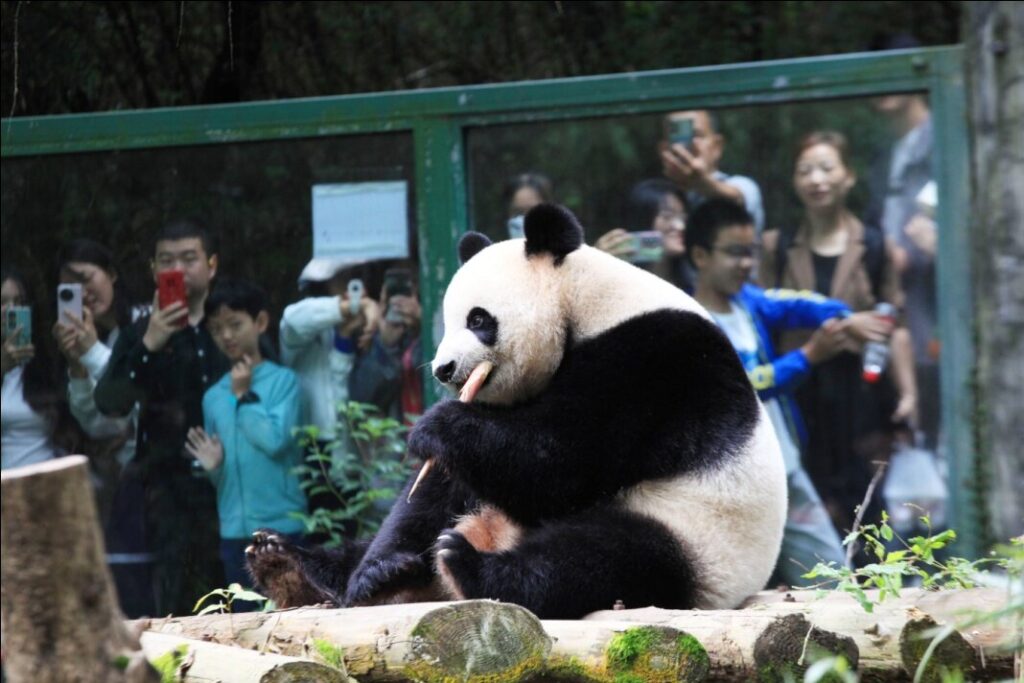The model walked elegantly into rhythmic music and displayed her latest streetwear collection in front of an intriguing audience. However, the setting was not a downtown runway. It was Hong Kong Forest Zoo.
“It’s incredible! You’d have thought this was a zoo, not a fashion venue,” cried Yang Ji, a tourist from Suzhou in Jiangsu Province.
Located in Nanjing, the capital of Jiangsu Province in eastern China, the zoo became one of China’s most popular “internet famous” destinations last year, attracting around 8 million visitors last year.
In addition to zoological exhibits, the zoo has become a favourite place for brand events, regular product launches and film promotions.
By embracing a constant commitment to innovation and a diverse consumer experience, Fragrance Forest Zoo successfully transcended the traditional paradigm of the zoo and attracted national attention.
“We want to gradually change people’s traditional perceptions of what a zoo is,” said Shenjun, director of the zoo. “By introducing cultural and creative products, co-branded fashion shows and product promotions, it integrates scientific research, conservation activities, culture and green consumption. This approach provides a wide range of experiences for visitors of all ages and backgrounds, and promotes awareness of animal welfare and environmental protection.
“Following the recommendations found online, Yang and her friends signed up for the zoo’s “Day & Night Camp,” hosted by the “Nature School.” Under the guidance of instructors, they observed the animals’ nighttime behavior in naturalistic environments and quietly crossed the grounds.
In the tranquility of the night, the scent of the earth permeated the air, accompanied by the rustling of nature. The giraffe curled its neck gently towards its body, and the red panda slept peacefully in the tree, and the Lynx wary of its surroundings.
What really struck me about Yang was watching a wolf pack “hold a meeting.” The Alpha Wolves howled, stretching their necks into the sky, followed by a Howl chorus from the pack.
“There are no staged performances or feeding sessions here. The animals are true hosts and visitors are respectful guests,” Yang said. She was impressed by the animal-friendly environment and the immersive experience of the zoo.
Beyond “day and night camping,” the zoo also offers a wide range of attractions. Visitors can observe koalas during their health check. You can fish for sal paddling boats or brown bears. You can also enjoy coffee beside the vast windows while the flamingos roam freely outside.
Plus, the Zoo’s Creative Marketplace features attractive cultural products ranging from white-faced Saki brooches and plush red panda keychains to otter pull string toys. The zoo currently boasts over 1,000 original cultural and creative items. Many of them are popular with visitors.
The growing popularity of zoos is also stimulating the local economy. Hotel rates nearby now rival those in downtown Nanjing, but local specialties such as salted ducks, crispy tofu noodles and vermicelli soup have become prominent in the city’s top cuisine rankings. The zoo has become the anchor of the fast-growing local consumption zone.
“Early, about 23% of our visitors come from Nanjing, 27% from other cities in Jiangsu, and almost half of the other states,” said Bai Yari, the zoo’s deputy director.
When asked about the visitors’ subsequent destinations, Bai showed that the growing presence of Hong Kong brands across the city plays a key role. Creative collaborations linked to co-branded retailers, themed stores and zoos have emerged throughout the commercial district. So far, the zoo has partnered with over 50 brands.
“We worked with Hongshan Forest Zoo last year. This year we will be working together again to create a more interactive experience and launch creative audio-ready products.”
Nanjing is actively developing urban brand assets such as Hongshan Forest Zoo and Central Business District Xinjiekou by cultivating new consumption scenarios and business models. Efforts are underway to promote integrated development across commerce, tourism, culture, sports and wellness to transform the popularity of zoos into sustainable consumer spending. In the first quarter of this year, total retail sales of Nanjing’s consumer goods reached 2323.1 billion yuan ($322.5 billion), placing the city among the fastest growing cities in Jiangsu.
When she left the zoo, Yang Zi had already made plans for her return. “I can’t wait to begin planning my next trip to Nanjing.”
yao xueqing (People’s Daily)

